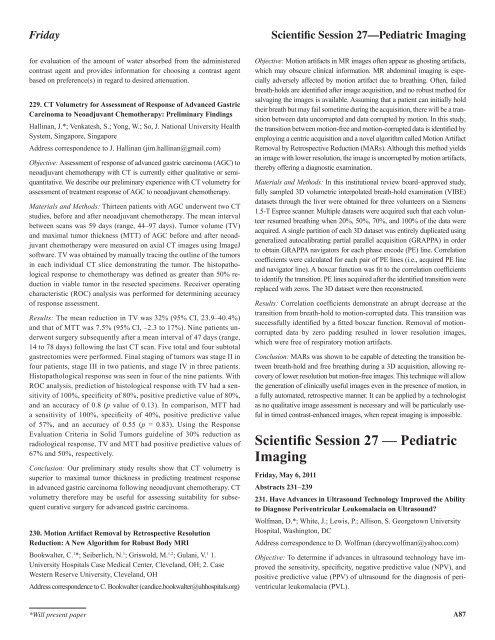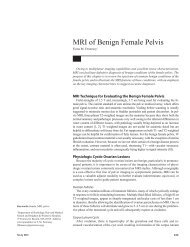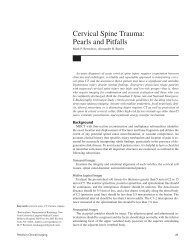<strong>Scientific</strong> <strong>Session</strong> 26—Gastrointestinal <strong>Imaging</strong>:Abdominal CT and MRI—TechniqueThursdaymary as well as secondary diagnoses. Each reader also indicated whetherthey would add a disclaimer to their report indicating that they had difficultyinterpreting the scan due to the smaller volume of contrast material.Results: In total, 63 contrast medium extravasation incidents were recordedin 2009, of which 46 studies met our inclusion criteria. Three of the studieswere not performed and no images were acquired. Of the 43 cases reviewed,all three reviewers agreed that 21 patient studies (49%) demonstrated no differencein the perceived amount of contrast medium. In four additional studies(9.3%), two out of three reviewers agreed that there was no difference inthe perceived amount of contrast medium. For 15 studies (35%), all threereviewers agreed that there was a lesser amount of contrast medium present.For 18 studies (42%), at least two out of three reviewers agreed that there wasa lesser amount of contrast medium present. We further analyzed the 18 studiesand found that the diagnostic impact as a result of contrast extravasationon 11 studies (61%) was moderate or severe. Additionally, for 13 out of the18 studies (72%), two out of three radiologists agreed that they would add adisclaimer to the interpretation indicating that the evaluation was limited bythe bolus of contrast medium present.Conclusion: Contrast medium extravasation leads to a significant impacton the diagnostic quality of a CT scan of abdomen and pelvis. It also leadsto decrease in reader confidence in their diagnostic ability to diagnose notonly the primary indication but also to evaluate incidental findings.227. Five Tier Weight-Based Contrast Bolus Protocol for LiverMDCT: Comparison to a Fixed Volume Protocol in the Same PatientsMitsumori, L.; Wang, C.; Koprowicz, K.; Lehnert, B.*; Kolokythas, O.;Dighe, M.; Cuevas, C.; Shuman, W. University of Washington, Seattle, WAAddress correspondence to L. Mitsumori (lmits@u.washington.edu)Objective: To evaluate a 5-tier weight-based contrast bolus protocol forliver CT scans by measuring the attenuation achieved in the aorta andliver parenchyma and comparing the results to a conventional fixed volumeinjection protocol in the same patient.Materials and Methods: Forty-eight patients underwent 64-slice multiphaseliver CT with a weight-based (WB group) contrast bolus protocol.Patients who weighed less than 55 kg received 90 mL of contrast agent;those weighing 56–75 kg, 100 mL; those weighing 76–85 kg, 120 mL;those weighing 86–95 kg, 135 mL; and those weighing over 95 kg, 150mL. The cases had prior scans done with a conventional fixed volume of155 mL of contrast agent (control group) and a 15-mL timing bolus, bothinjected at 5 mL/s. The same contrast agent was used for all examinations(350 mg I/mL). Regions of interest were drawn in the aorta and liverto measure the attenuation achieved with the two contrast protocols inthe arterial (AP) and portal venous (PVP) phases of each scan. Delayedphase was not assessed due to different delay times between the WBand control cases (5 vs 10 min). The measured attenuation, amount ofcontrast agent administered per weight tier, and regression of attenuationversus weight between the WB and control groups were compared.Results: The amount of contrast agent (mg I/kg) administered with the WBprotocol was significantly lower (p < 0.001) than the control group, while theattenuation of the aorta (AP) was not significantly different between the WBand control groups (p > 0.05) for all weight tiers. The PVP liver attenuationof patients less than 85 kg was lower in the WB group by an average of 26.7HU (p < 0.05) but was not significantly different between the two groupsin the heavier weight tiers. Regression of patient weight versus attenuationrevealed lower negative slopes with both aorta attenuation (WB slope –0.63,control –1.29) and liver attenuation (WB slope –0.26, control –0.49).Conclusion: In these study patients, a 5-tier WB contrast bolus protocolresulted in a smaller amount of administered contrast agent and a lowernegative weight dependence of image attenuation when compared with afixed volume bolus protocol. While the AP aorta attenuation was similarbetween WB and control groups for all weight tiers, the PVP liver attenuationwas lower with the current WB protocol in smaller patients by an averageof 26.7 HU. Implementation of a weight-based contrast bolus protocolcan reduce the amount of contrast agent administered over a group of patientsand reduce the weight dependence of the resulting image attenuation.228. Oral Contrast Agents for CT: A Retrospective Comparison ofTransit Times, Side Effects, and Time-Density RelationshipsQuagliano, P. 1,2 * 1. McGuire Veterans Affairs Medical Center,Richmond, VA; 2. Virginia Commonwealth University, Richmond, VAAddress correspondence to P. Quagliano (QFamiglia@aol.com)Objective: The purpose of this study was to compare the bowel transittimes, side effects, and time-density relationships of representative oralcontrast agents for CT.Materials and Methods: This study retrospectively evaluated the abdominopelvicCT images of 674 adults. Each subject consumed 900–1000 mLof an oral contrast agent following a standardized regimen. Standardizedtransit times were calculated by recording the location of the most distalcontrast in the bowel relative to the time interval from initial contrast agentconsumption, with larger calculated numbers representing faster transit.The palatability score (range, 0–10 with 10 the most palatable) and incidencesof side effects were determined using patient surveys. The highestattenuation was determined for oral contrast agent present in the stomach,mid jejunum, distal ileum, mid ascending colon, and mid descending colon.Results: Standardized transit times; palatability score; and the incidenceof nausea, emesis, mild diarrhea, severe diarrhea, mild constipation, andsevere constipation were as follows: Cheetah (Covidien) (4.3, 6.4, 11%,2%, 34%, 24%, 7%, 0%); Gastrografin (Bracco) with Breeza (Beekley)(4.4, 8.4, 6%, 0%, 47%, 7%, 4%, 0%); Gastrografin with Kool-Aid (KraftFoods) (4.0, 7.3, 10%, 1%, 39%, 5%, 10%, 3%); iohexol (GE Healthcare)with Aquafina Alive (PepsiCo) (3.6, 8.6, 5%, 2%, 15%, 3%, 3%, 0%);iohexol with Breeza for nonionics (4.1, 9.0, 8%, 0%, 38%, 4%, 6%,3%); Readi-Cat (Bracco) (4.1, 5.3, 14%, 2%, 41%, 9%, 5%, 6%); ScanC (Covidien) (4.9, 6.9, 16%, 2%, 46%, 21%, 8%, 5%); and SmoothieReadi-Cat 2 (Bracco) (4.4, 6.9, 18%, 2%, 41%, 6%, 12%, 0%).Conclusion: The study presents data on the transit times, side effects,and attenuation of eight representative oral contrast agents used for CT.Knowledge of the potential advantages and disadvantages of the variousoral contrast agents allows the proper choice of contrast agent and administrationprotocol to fit a specific patient indication. Transit time dataprovide a basis for matching contrast agent with administration protocolfor opacification of the primary area of interest. Side effects data providea basis for choosing an alternative contrast agent for a patient whoreports a problem with a particular agent. Attenuation provides a proxyA86*Will present paper
Friday<strong>Scientific</strong> <strong>Session</strong> 27—Pediatric <strong>Imaging</strong>for evaluation of the amount of water absorbed from the administeredcontrast agent and provides information for choosing a contrast agentbased on preference(s) in regard to desired attenuation.229. CT Volumetry for Assessment of Response of Advanced GastricCarcinoma to Neoadjuvant Chemotherapy: Preliminary FindingsHallinan, J.*; Venkatesh, S.; Yong, W.; So, J. National University HealthSystem, Singapore, SingaporeAddress correspondence to J. Hallinan (jim.hallinan@gmail.com)Objective: Assessment of response of advanced gastric carcinoma (AGC) toneoadjuvant chemotherapy with CT is currently either qualitative or semiquantitative.We describe our preliminary experience with CT volumetry forassessment of treatment response of AGC to neoadjuvant chemotherapy.Materials and Methods: Thirteen patients with AGC underwent two CTstudies, before and after neoadjuvant chemotherapy. The mean intervalbetween scans was 59 days (range, 44–97 days). Tumor volume (TV)and maximal tumor thickness (MTT) of AGC before and after neoadjuvantchemotherapy were measured on axial CT images using ImageJsoftware. TV was obtained by manually tracing the outline of the tumorsin each individual CT slice demonstrating the tumor. The histopathologicalresponse to chemotherapy was defined as greater than 50% reductionin viable tumor in the resected specimens. Receiver operatingcharacteristic (ROC) analysis was performed for determining accuracyof response assessment.Results: The mean reduction in TV was 32% (95% CI, 23.9–40.4%)and that of MTT was 7.5% (95% CI, –2.3 to 17%). Nine patients underwentsurgery subsequently after a mean interval of 47 days (range,14 to 78 days) following the last CT scan. Five total and four subtotalgastrectomies were performed. Final staging of tumors was stage II infour patients, stage III in two patients, and stage IV in three patients.Histopathological response was seen in four of the nine patients. WithROC analysis, prediction of histological response with TV had a sensitivityof 100%, specificity of 80%, positive predictive value of 80%,and an accuracy of 0.8 (p value of 0.13). In comparison, MTT hada sensitivity of 100%, specificity of 40%, positive predictive valueof 57%, and an accuracy of 0.55 (p = 0.83). Using the ResponseEvaluation Criteria in Solid Tumors guideline of 30% reduction asradiological response, TV and MTT had positive predictive values of67% and 50%, respectively.Conclusion: Our preliminary study results show that CT volumetry issuperior to maximal tumor thickness in predicting treatment responsein advanced gastric carcinoma following neoadjuvant chemotherapy. CTvolumetry therefore may be useful for assessing suitability for subsequentcurative surgery for advanced gastric carcinoma.230. Motion Artifact Removal by Retrospective ResolutionReduction: A New Algorithm for Robust Body MRIBookwalter, C. 1 *; Seiberlich, N. 1 ; Griswold, M. 1,2 ; Gulani, V. 1 1.University Hospitals Case Medical Center, Cleveland, OH; 2. CaseWestern Reserve University, Cleveland, OHAddress correspondence to C. Bookwalter (candice.bookwalter@uhhospitals.org)Objective: Motion artifacts in MR images often appear as ghosting artifacts,which may obscure clinical information. MR abdominal imaging is especiallyadversely affected by motion artifact due to breathing. Often, failedbreath-holds are identified after image acquisition, and no robust method forsalvaging the images is available. Assuming that a patient can initially holdtheir breath but may fail sometime during the acquisition, there will be a transitionbetween data uncorrupted and data corrupted by motion. In this study,the transition between motion-free and motion-corrupted data is identified byemploying a centric acquisition and a novel algorithm called Motion ArtifactRemoval by Retrospective Reduction (MARs). Although this method yieldsan image with lower resolution, the image is uncorrupted by motion artifacts,thereby offering a diagnostic examination.Materials and Methods: In this institutional review board–approved study,fully sampled 3D volumetric interpolated breath-hold examination (VIBE)datasets through the liver were obtained for three volunteers on a Siemens1.5-T Espree scanner. Multiple datasets were acquired such that each volunteerresumed breathing when 20%, 50%, 70%, and 100% of the data wereacquired. A single partition of each 3D dataset was entirely duplicated usinggeneralized autocalibrating partial parallel acquisition (GRAPPA) in orderto obtain GRAPPA navigators for each phase encode (PE) line. Correlationcoefficients were calculated for each pair of PE lines (i.e., acquired PE lineand navigator line). A boxcar function was fit to the correlation coefficientsto identify the transition. PE lines acquired after the identified transition werereplaced with zeros. The 3D dataset were then reconstructed.Results: Correlation coefficients demonstrate an abrupt decrease at thetransition from breath-hold to motion-corrupted data. This transition wassuccessfully identified by a fitted boxcar function. Removal of motioncorrupteddata by zero padding resulted in lower resolution images,which were free of respiratory motion artifacts.Conclusion: MARs was shown to be capable of detecting the transition betweenbreath-hold and free breathing during a 3D acquisition, allowing recoveryof lower resolution but motion-free images. This technique will allowthe generation of clinically useful images even in the presence of motion, ina fully automated, retrospective manner. It can be applied by a technologistas no qualitative image assessment is necessary and will be particularly usefulin timed contrast-enhanced images, when repeat imaging is impossible.<strong>Scientific</strong> <strong>Session</strong> 27 — Pediatric<strong>Imaging</strong>Friday, May 6, 2011Abstracts 231-239231. Have Advances in Ultrasound Technology Improved the Abilityto Diagnose Periventricular Leukomalacia on Ultrasound?Wolfman, D.*; White, J.; Lewis, P.; Allison, S. Georgetown UniversityHospital, Washington, DCAddress correspondence to D. Wolfman (darcywolfman@yahoo.com)Objective: To determine if advances in ultrasound technology have improvedthe sensitivity, specificity, negative predictive value (NPV), andpositive predictive value (PPV) of ultrasound for the diagnosis of periventricularleukomalacia (PVL).*Will present paperA87
















